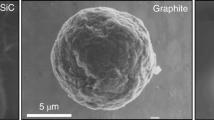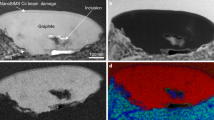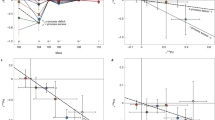Abstract
Primitive Solar System materials host small amounts of refractory dust grains predating the formation of the Sun and its planetary system. These ‘presolar’ grains condensed in the ejecta of evolved stars, novae and supernovae1. Their highly anomalous isotopic compositions cannot be explained by chemical or physical processes within the Solar System; instead, they represent the nucleosynthetic signatures of their stellar parents. Among this ‘true stardust’, silicates are the most abundant type of dust available for single-grain analyses2, with typical sizes of approximately 150 nm (ref. 3). Unlike presolar silicon carbides, aluminium oxides or graphites, which can be separated chemically from meteorites, presolar silicates have to be identified in situ, as they would be destroyed by extraction agents. Instrumental restrictions have constrained almost all previous magnesium isotopic measurements to presolar aluminium oxides, and the contribution of radiogenic 26Mg from 26Al decay has precluded unambiguous conclusions about their initial magnesium isotopes. Recent technical advances have enabled the undisturbed in situ investigation of magnesium isotopes in presolar silicates with unprecedented spatial resolution (<150 nm). Here we show that a minor but important fraction of silicate stardust believed to come from red giant stars has a supernova origin instead, if hydrogen ingestion occurred during the pre-supernova phase, making the supernova dust fraction among >200-nm-sized presolar silicates significantly higher than previously inferred1.
This is a preview of subscription content, access via your institution
Access options
Access Nature and 54 other Nature Portfolio journals
Get Nature+, our best-value online-access subscription
$29.99 / 30 days
cancel any time
Subscribe to this journal
Receive 12 digital issues and online access to articles
$119.00 per year
only $9.92 per issue
Buy this article
- Purchase on Springer Link
- Instant access to full article PDF
Prices may be subject to local taxes which are calculated during checkout




Similar content being viewed by others
Data availability
The data that support the plots within this paper and other findings of this study are available from the corresponding author upon reasonable request.
References
Zinner, E. in Meteorites and Cosmochemical Processes Vol. 1 (ed. Davis, A. M.) 181–213 (Elsevier, 2014).
Floss, C. & Haenecour, P. Presolar silicate grains: abundances, isotopic and elemental compositions, and the effects of secondary processing. Geochem. J. 50, 3–25 (2016).
Hoppe, P., Leitner, J. & Kodolányi, J. The stardust abundance in the local interstellar cloud at the birth of the Solar System. Nat. Astron. 1, 617–620 (2017).
Hoppe, P., Leitner, J. & Kodolányi, J. New insights into the Galactic chemical evolution of magnesium and silicon isotopes from studies of silicate stardust. Astrophys. J. 869, 47–59 (2018).
Nittler, L. R., Alexander, C. M. O’D., Gao, X., Walker, R. M. & Zinner, E. Stellar sapphires: the properties and origins of presolar Al2O3 in meteorites. Astrophys. J. 483, 475–495 (1997).
Nittler, L. R. et al. Aluminum-, calcium- and titanium-rich oxide stardust in ordinary chondrite meteorites. Astrophys. J. 682, 1450–1478 (2008).
Cristallo, S., Straniero, O., Piersanti, L. & Gobrecht, D. Evolution, nucleosynthesis, and yields of AGB stars at different metallicities. III. Intermediate-mass models, revised low-mass models, and the pH-FRUITY interface. Astrophys. J. Suppl. Ser. 219, 40–60 (2015).
Zinner, E. et al. Oxygen, magnesium and chromium isotopic ratios of presolar spinel grains. Geochim. Cosmochim. Acta 69, 4149–4165 (2005).
Palmerini, S., La Cognata, M., Cristallo, S. & Busso, M. Deep mixing in evolved stars. I. The effect of reaction rate revisions from C to Al. Astrophys. J. 729, 3–23 (2011).
Lugaro, M. et al. Origin of meteoritic stardust unveiled by a revised proton-capture rate of 17O. Nat. Astron. 1, 0027 (2017).
Nguyen, A. N. & Messenger, S. Resolving the stellar sources of isotopically rare presolar silicate grains through Mg and Fe isotopic analyses. Astrophys. J. 784, 149–163 (2014).
Hoppe, P., Leitner, J. & Kodolányi, J. New constraints on the abundances of silicate and oxide stardust from supernovae in the Acfer 094 meteorite. Astrophys. J. 808, L9–L14 (2015).
Gyngard, F., Nittler, L. R., Zinner, E., Jose, J. & Cristallo, S. New reaction rates and implications for nova nucleosynthesis and presolar grains. Lunar Planet. Sci. 42, 2675 (2011).
Leitner, J., Kodolányi, J., Hoppe, P. & Floss, C. Laboratory analysis of presolar silicate stardust from a nova. Astrophys. J. 754, L41–L46 (2012).
Karakas, A. I. & Lattanzio, J. C. Production of aluminium and the heavy magnesium isotopes in asymptotic giant branch stars. Publ. Astron. Soc. Aust. 20, 279–293 (2003).
Karakas, A. I. & Lugaro, M. Stellar yields from metal-rich asymptotic giant branch models. Astrophys. J. 825, 26–47 (2016).
Pignatari, M. et al. NuGrid stellar data set. I. Stellar yields from H to Bi for stars with metallicities Z = 0.02 and Z = 0.01. Astrophys. J. Suppl. Ser. 225, 24–77 (2016).
José, J., Hernanz, M., Amari, S., Lodders, K. & Zinner, E. The imprint of nova nucleosynthesis in presolar grains. Astrophys. J. 612, 414–428 (2004).
Pignatari, M. et al. Carbon-rich presolar grains from massive stars: subsolar 12C/13C and 14N/15N ratios and the mystery of 15N. Astrophys. J. 808, L43–L48 (2015).
Iliadis, C., Downen, L. N., José, J., Nittler, L. R. & Starrfield, S. On presolar stardust grains from CO classical novae. Astrophys. J. 855, 76–89 (2018).
Nittler, L. R. & Hoppe, P. Are presolar silicon carbide grains from novae actually from supernovae? Astrophys. J. 631, L89–L92 (2005).
Liu, N. et al. Stellar origins of extremely 13C- and 15N-enriched presolar SiC grains: novae or supernovae? Astrophys. J. 820, 140–153 (2016).
Orlando, S., Miceli, M., Pumo, M. L. & Bocchino, F. Supernova 1987A: a template to link supernovae to their remnants at 10,000 days. Astrophys. J. 810, 168–182 (2015).
Harris, M. J. & Lambert, D. L. Oxygen isotopes in the atmospheres of Betelgeuse and Antares. Astrophys. J. 281, 739–745 (1984).
Neilson, H., Lester, J. B. & Haubois, X. Weighing Betelgeuse: measuring the mass of α Orionis from stellar limb-darkening. In 9th Pacific Rim Conference on Stellar Astrophysics ASP Conf. Ser. 451 (eds Qian, S., Leung, K., Zhu, L. & Kwok, S.) 117–122 (ASP, 2011).
Kudritzki, R. P. & Reimers, D. On the absolute scale of mass-loss in red giants. II. Circumstellar absorption lines in the spectrum of α Sco B and mass-loss of α Sco A. Astron. Astrophys. 70, 227–239 (1978).
Ramírez, S. V. et al. Stellar iron abundances at the Galactic Center. Astrophys. J. 537, 205–220 (2000).
Rauscher, T., Heger, A., Hoffman, R. D. & Woosley, S. E. Nucleosynthesis in massive stars with improved nuclear and stellar physics. Astrophys. J. 576, 323–348 (2002).
Gehrz, R. D., Truran, J. W., Williams, R. E. & Starrfield, S. Nucleosynthesis in classical novae and its contribution to the interstellar medium. Publ. Astron. Soc. Pac. 110, 3–26 (1998).
Hoppe, P., Cohen, S. & Meibom, A. NanoSIMS: technical aspects and applications in cosmochemistry and biological geochemistry. Geostand. Geoanal. Res. 37, 111–154 (2013).
Kodolányi, J., Hoppe, P., Gröner, E., Pauly, C. & Mücklich, F. The Mg isotope composition of presolar silicate grains from red giant stars. Geochim. Cosmochim. Acta 140, 577–605 (2014).
Leitner, J., Hoppe, P., Floss, C., Hillion, F. & Henkel, T. Correlated nanoscale characterization of a unique complex oxygen-rich stardust grain: implications for circumstellar dust formation. Geochim. Cosmochim. Acta 221, 255–274 (2018).
Nittler, L. R., Alexander, C. M. O’D., Liu, N. & Wang, J. Extremely 54Cr- and 50Ti-rich presolar oxide grains in a primitive meteorite: formation in rare types of supernovae and implications for the astrophysical context of Solar System birth. Astrophys. J. 856, L24–L30 (2018).
Leitner, J., Vollmer, C., Floss, C., Zipfel, J. & Hoppe, P. Ancient stardust in fine-grained chondrule dust rims from carbonaceous chondrites. Earth Planet. Sci. Lett. 434, 117–128 (2016).
José, J. & Hernanz, M. Nucleosynthesis in classical novae: CO versus ONe white dwarfs. Astrophys. J. 494, 680–690 (1998).
Woosley, S. E. & Heger, A. Nucleosynthesis and remnants in massive stars of solar metallicity. Phys. Rep. 442, 269–283 (2007).
Acknowledgements
We thank E. Gröner, P. Schuhmann and A. Sorowka for technical support, the Natural History Museum in Vienna for the loan of the Acfer 094 sample, and NASA JSC for the loan of the EET 92161 sample. US Antarctic meteorite samples were recovered by the Antarctic Search for Meteorites (ANSMET) programme funded by the National Science Foundation and NASA, and characterized and curated by the Department of Mineral Sciences of the Smithsonian Institution and Astromaterials Curation Office at NASA Johnson Space Center. This work was supported by the Max Planck Society and the Deutsche Forschungsgemeinschaft (J.L., grant LE3279/1-1) and has made use of NASA’s Astrophysics Data System.
Author information
Authors and Affiliations
Contributions
J.L. conducted the majority of the NanoSIMS work with minor contributions from P.H. J.L. wrote most of the paper with important input from P.H.
Corresponding author
Ethics declarations
Competing interests
The authors declare no competing interests.
Additional information
Journal peer review information: Nature Astronomy thanks Davide Lazzati and the other anonymous reviewer(s) for their contribution to the peer review of this work.
Publisher’s note: Springer Nature remains neutral with regard to jurisdictional claims in published maps and institutional affiliations.
Supplementary information
Supplementary Information
Supplementary Figure 1-10, Supplementary Table 1-2, Supplementary references 1-20.
Rights and permissions
About this article
Cite this article
Leitner, J., Hoppe, P. A new population of dust from stellar explosions among meteoritic stardust. Nat Astron 3, 725–729 (2019). https://doi.org/10.1038/s41550-019-0788-x
Received:
Accepted:
Published:
Issue Date:
DOI: https://doi.org/10.1038/s41550-019-0788-x
This article is cited by
-
Dust from supernovae and their progenitors in the solar nebula
Nature Astronomy (2022)
-
The Dawn of Dust Astronomy
Space Science Reviews (2019)



